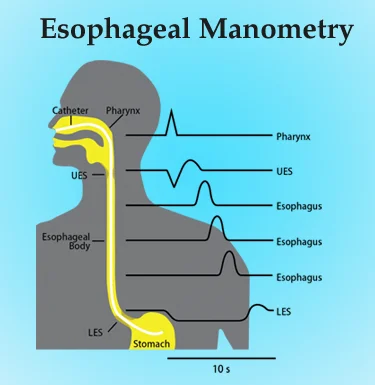- Home
- Departments
Departments Of Manometry
ManometryManometry is a diagnostic procedure used to assess the function and motility of the gastrointestinal (GI) tract, particularly the esophagus, stomach, and anus. It measures the pressure exerted by the muscles within these organs and helps diagnose disorders such as gastroesophageal reflux disease (GERD), achalasia, dysphagia, and anorectal disorders.
There are several types of manometry procedures, each tailored to evaluate specific regions of the GI tract:
Esophageal Manometry: Esophageal manometry assesses the function of the muscles in the esophagus, which are responsible for propelling food and liquids from the mouth to the stomach. During the procedure, a thin, flexible tube with pressure sensors is passed through the nose or mouth into the esophagus. The patient is then asked to swallow water or a saline solution while the pressure sensors measure the contractions and relaxation of the esophageal muscles. This helps identify abnormalities such as weak muscle contractions, ineffective peristalsis, or high pressure in the lower esophageal sphincter (LES), which can contribute to conditions like GERD or achalasia.
Anorectal Manometry: Anorectal manometry evaluates the function of the muscles in the rectum and anus, which are responsible for bowel movements and continence. During the procedure, a small, flexible catheter with pressure sensors is inserted into the rectum. The patient is then asked to perform specific tasks, such as squeezing or relaxing the muscles, while the pressure sensors measure the strength and coordination of the muscles. Anorectal manometry helps diagnose conditions such as fecal incontinence, chronic constipation, or pelvic floor dysfunction.
High-resolution Manometry (HRM): High-resolution manometry is an advanced technique that provides detailed, three-dimensional mapping of pressure patterns in the GI tract. It uses a catheter with multiple pressure sensors spaced closely together, allowing for more precise measurement of muscle activity and coordination. HRM is particularly useful for assessing esophageal motility disorders, as it provides higher resolution and more accurate data compared to conventional manometry techniques.
Manometry is a safe and well-tolerated procedure that is typically performed in a specialized motility laboratory by trained healthcare professionals. It provides valuable information about the function of the GI tract, helping clinicians diagnose underlying conditions and develop targeted treatment plans for their patients. Overall, manometry plays a crucial role in the evaluation and management of a wide range of GI disorders, ultimately improving patient outcomes and quality of life.

